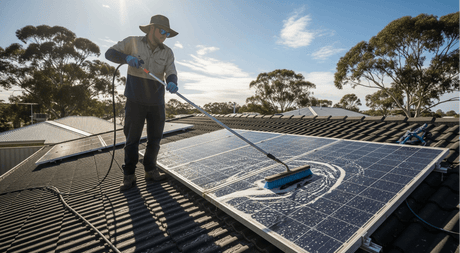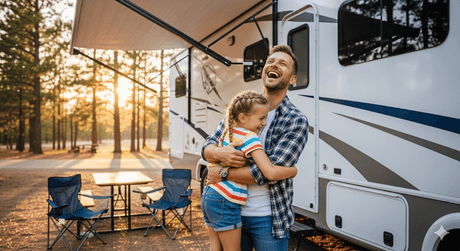Are you a homeowner who wants sustainability, independence, and freedom from rising electricity bills? If so, look no further than living off-grid.
When we say running a house off-grid, it means you don't need a power supply from the utility grid to run your devices and appliances at home. This is where solar energy comes in handy. The basic components of an off-grid solar setup include solar panels, deep cycle batteries, a charge controller, an inverter, and a backup generator (optional).
When it comes to going solar, everyone is concerned about "How many solar panels do I need to run a house off-grid". In this article, you will see whether or not you can power an entire home on solar power, how many panels you need, and the cost of installing an off-grid solar system.
Can Solar Panels Power an Entire House?
Yes, you can run the whole house on solar panels, but the process might be different from what you think. Solar panels can run your home appliances and devices during the daytime only. The excess energy produced during the daytime is sent to the grid to get electric bill credits. This process is known as net metering.
Then, at night or during cloudy weather, you can use these credits to power your home when your solar power system does not produce electricity. But when you are connected to the grid, it will not be considered an off-grid solution. If you want to run an entire house on solar energy, you will need solar batteries to store excess energy and use it at night or when the solar system does not generate power.

How Many Solar Panels Do You Need to Run a House Off-Grid?
Are you wondering, "How many kW solar do I need to run a house off-grid?" There is no single-line answer to this question, as it depends on several factors, such as your energy consumption, location, and peak sunlight hours. Let's look at these factors one by one.
1. Determine Your Energy Needs
If you want to calculate the number of panels required to power your house, you need to estimate your energy consumption first. Now the question that arises here is, “How to know the energy consumption of my house?” Is this what you have in mind?
Well, you can find the detailed information about the energy consumption of your house on your electricity bills. They show monthly and annual power consumption in kilowatt-hours (kWh).
Sum up the monthly power consumption of the past year and divide the answer by 12 to calculate your average monthly energy usage. Now, divide the answer by 30.5 to get your daily consumption. If you want to get an idea about the average energy you use hourly, divide the average daily consumption by 24.
2. Consider the Location
Once you know your energy consumption, the next thing to consider is the location. The accurate positioning of solar panels depends on the location of your house. Don't forget to consider high-rise buildings and trees, as they may partially stop sunlight from reaching the panels, resulting in reduced output power. If you have a small roof, you can install solar panels on the ground.
If your roof has a couple of strange angles or is small, you may not be able to install enough solar panels. Ground-mounted solar power systems offer easy installation, better energy production, and easier maintenance than roof-mounted systems. At the same time, ground-mounted systems take up more space, and their installation can be a leading issue for some homeowners.
The table below shows how much space you need to install systems of different sizes.
| Roof Space (Sq. ft) | System Size (kW) | Number of Panels Required |
| 177 | 4 | 10 |
| 265 | 6 | 15 |
| 353 | 8 | 20 |
| 442 | 10 | 25 |
| 530 | 12 | 30 |
3. Determine the Amount of Sunlight Your House Receives
The amount of sunlight your home receives or peak sunlight hours play a crucial role in determining the number of solar panels you need to run a house off-grid. Suppose your home does not receive a lot of sunlight. In that case, you will need more solar panels to fulfil your power requirements. At the same time, you will need more space to install a system with more panels.
In case you don't know, peak sunlight hours mean the time of the day when the sun shines at its peak and provides a high amount of energy to the panels. Peak hours are typically between 9 am and 3 pm when the sun shines directly from the top and there are no shady areas or clouds. Considering peak sunlight hours is crucial to estimate the number of solar panels you need to power your whole house.
4. Take Into Account the Size and Efficiency of Panels
Once you calculate your energy consumption and consider your location and peak sunlight hours, it is time to choose a system to fulfil your requirements. Remember, solar panels do not operate at 100% efficiency. Therefore, make sure the total wattage or size of your solar panels is greater than your daily energy consumption (which we have calculated earlier).
To ensure your solar power system can handle the full load, install the system with at least 25% higher power output capacity than your average energy consumption.
For example, if you use 10 kWh a day to run your whole house, your solar panels should generate 10,000 watts during the peak hours. If your roof receives 5 hours of peak sunlight, the total wattage of your solar panels should be 2,000 watts. If you use a 400W panel, you will need a total of 5 panels. If you want to install 200W panels, you will need 10 solar panels.
Since we have to consider a system with 25% higher capacity, you will need a 12.5kW solar system to handle the full load of 10kWh. If you use 200W panels, you will need 13 (to be exact, 12.5) solar panels (including extra capacity) to run a whole house off-grid. The formula to calculate the number of solar panels is as follows.
Number of Solar Panels Required = Total Power Consumption / (Panel Wattage x Peak Hours)
How Much Does an Off-Grid Solar System Cost for a House?
Well, it is a fact that solar power systems come with a high upfront cost. On the other hand, they provide you with a cost-effective, long-term power solution, as you don't have to pay a monthly fee like you do for your electricity bills. Additionally, the cost of a solar system varies depending on your energy needs. More consumption means a more expensive system.
If you need a system to run an entire house off-grid, you will have to consider the cost of equipment (such as solar panels, an inverter, battery storage, a charge controller, a mounting structure, etc.) and installation. Considering your power consumption, peak sunlight hours, and the number of solar panels required, an off-grid home solar system can cost you anywhere between $25,000 and $45,000, according to Energy Matters Australia.
Valuable Tips for Off-Grid Solar Success
Off-grid solar systems are more expensive than on-grid systems, as they need dedicated battery storage. Therefore, you should focus on extending their lifespans to get the maximum out of your investment. Below is a list of a few tips you should follow to make your off-grid solar system operate at its full potential and efficiency.
- Use energy-efficient appliances (such as induction stoves and Energy Star-rated refrigerators) to prevent your system from overloading.
- Follow smart energy management practices. For example, you can run dryers, washers, ovens, air conditioners, and other energy-hungry devices during the daytime when the sun shines the most.
- Plan for seasonal variations effectively. It works best in winter.
- Keep your solar panels and batteries well-maintained so that they can function properly for an extended period.
Final Thoughts
If you are wondering how many solar panels do I need to power my house, it depends on various factors, including your daily power consumption rate, peak sunlight hours, battery capacity, and panel efficiency. According to Smart Lifestyle Australia (SLA), the typical daily energy consumption is 18kWh. If you have similar energy requirements, you will need 9 to 12 solar panels (400W each).
Though off-grid solar systems are expensive, they offer a range of benefits, such as a sustainable lifestyle, long-term savings, and true energy independence. If you want your off-grid solar system to support your home year-round, make sure that you use energy-efficient appliances and follow smart energy management practices.
Frequently Asked Questions
Is it cost-effective to go solar off-grid instead of getting connected to the grid?
The initial cost of installing an off-grid solar system on your house is high, but it becomes cost-effective in the long run, as it saves you money on electricity bills and helps you achieve energy independence. Interestingly, off-grid solar power is more affordable in remote areas than installing power lines.
Can solar panels run my off-grid house without batteries?
If you install solar panels on your off-grid house, you will get the required power during the daytime only. Solar batteries are required for storing excess energy and using it on cloudy days or at night. Therefore, you can't even think of running your off-grid house on solar panels without batteries.
How long can solar panels and batteries power my house?
Premium-quality solar panels come with a 25 to 30-year warranty with minimal efficiency loss. On the other hand, the average lifespan of batteries is between 3 and 15 years with regular maintenance. The shelf life of your solar equipment largely depends on the quality of the product you install.

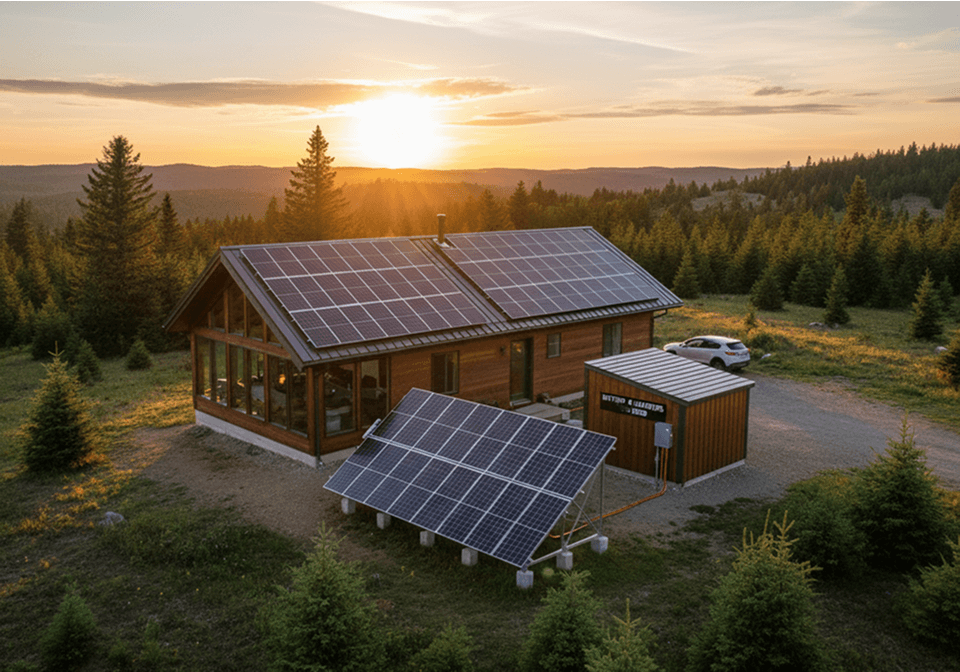



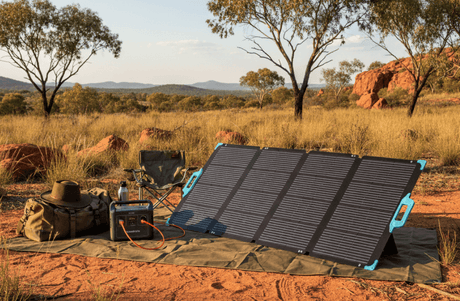
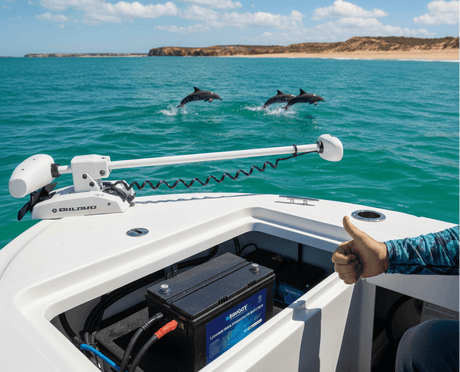
![What Is a DC to DC Battery Charger [Comprehensive Guide]](http://au.renogy.com/cdn/shop/articles/IMG_3829_bd86de74-31d6-49fd-b9d5-265bb723091d.jpg?v=1757582605&width=460)
